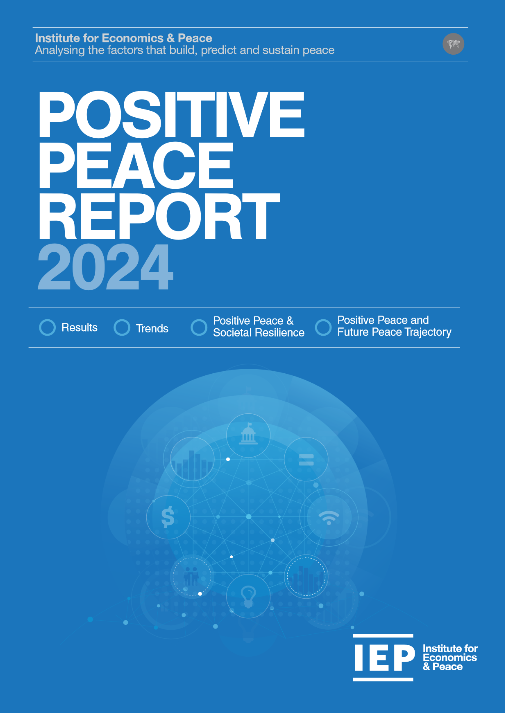Global Positive Peace Index Improved by 1%
The Institute for Economics and Peace’s index on the attitudes, institutions, and structures that create and sustain peace shows an optimistic trend from the baseline set ten years ago.
The Institute for Economics and Peace’s index on the attitudes, institutions, and structures that create and sustain peace shows an optimistic trend from the baseline set ten years ago.
The Positive Peace Index (PPI) has improved by 1 percent over the last decade across 163 countries. The PPI, developed by the Institute for Economics and Peace, is a measure of societal and global peacefulness, going beyond the mere absence of violence and incorporating indicators of eight Positive Peace Pillars, covering three main domains: attitudes, structures, and institutions. The index includes indicators of political stability, effective governance, economic equity, and social cohesion. Countries that score high on this index typically demonstrate strong institutions and robust social structures, which enhance their ability to withstand and recover from conflicts and economic shocks.
A higher ranking in the Positive Peace Index signifies not only greater peacefulness and resilience to conflict—it also correlates strongly with measures of societal resilience. Between 2009 and 2022, countries that saw improvements in their PPI experienced per capita GDP growth twice as high as that of countries with declining PPI scores. Additionally, these nations reported higher levels of happiness and life satisfaction, highlighting the broader correlation of a high PPI with quality of life and economic prosperity, which in turn further contributes to peace.
Historically, a Positive Peace deficit has been a strong predictor of violence globally. For example, Georgia had a slight Positive Peace surplus in 2009 while Venezuela had a slight deficit, and the subsequent events in these countries closely mirrored their PPI scores. Countries that face significant Positive Peace deficits as of 2022, such as Equatorial Guinea, Angola, and Laos, which currently exhibit considerable deficits, may be at greater risk of escalating violence over the next decade.
Looking closely at the index, despite the overall improvement in the PPI, the “structures” domain remains the only area to have shown global progress since 2013. This domain encompasses indicators such as GDP per capita, freedom of the press, telecommunications infrastructure, and research and development investments. In contrast, indicators within the “attitude” and “institutions” domains have generally deteriorated over the same period. This decline reflects growing challenges in social cohesion, political stability, and governance effectiveness, highlighting a widening gap between advancements in structural factors and setbacks in broader aspects of societal resilience and stability. The disparity underscores the need for targeted efforts to address weaknesses in attitudes and institutions to achieve more comprehensive and lasting improvements in global peace.
While PPI has shown notable improvements over the past decade, the disparities between the structural domain and other pillars are concerning. Advances in the economy and technology—such as increases in GDP per capita and enhancements in telecommunications—are promising. However, without parallel progress in governance, accountability, and effective institutions, these gains may have unintended negative consequences. Economic and technological advancements could exacerbate inequalities or reinforce power imbalances if not accompanied by strong, transparent, and responsive governance. This could lead to the suppression of citizens’ freedoms and the undermining overall societal well-being. Addressing these imbalances is crucial to ensuring that structural improvements genuinely support global peace and stability.
Globally, the most significant deterioration in the PPI occurred during the COVID-19 pandemic. This shift is closely linked to the profound economic, social, and health impacts of the pandemic, as well as the policies implemented to curb the virus’s spread. The crisis exposed vulnerabilities in societal structures and governance, contributing to a decline in peacefulness. However, countries with higher PPI scores demonstrated notable resilience and a more rapid recovery as the pandemic unfolded.
North America experienced the only significant deterioration in the PPI. This decline was primarily driven by substantial drops in the Positive Peace score of the United States, while Canada saw a more modest decrease. The largest decline in the U.S. can be attributed to fragmented elites and heightened tensions following the 2020 presidential election. Additionally, indicators such as the quality of information, legal frameworks supporting equal treatment, and group grievances have worsened, reflecting increasing divisions within society.
The Positive Peace Index (PPI) has seen a relatively significant 1 percent global improvement over the past decade, primarily driven by advances in economic and technological factors. However, this progress is complemented by deteriorations in governance, social cohesion, and institutional effectiveness. Strengthening governance and social cohesion remains essential for leveraging peace advancements and fostering long-term societal well-being. Looking ahead, addressing the significant Positive Peace deficits in nations such as Equatorial Guinea, Angola, and Laos, among many others, is crucial to preventing increased violence and ensuring sustainable global stability.
Cover image of the report and graph below by the Institute for Economics and Peace.

